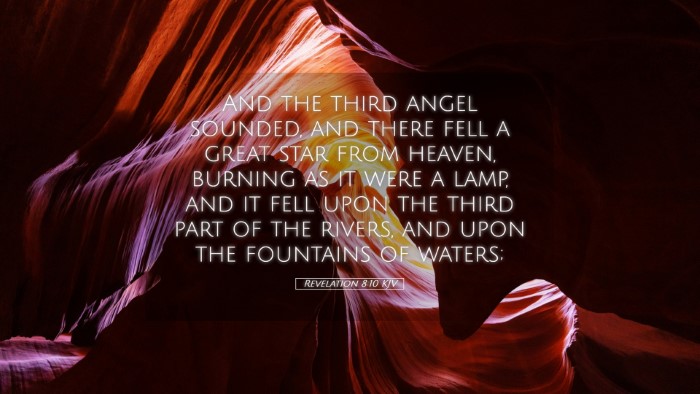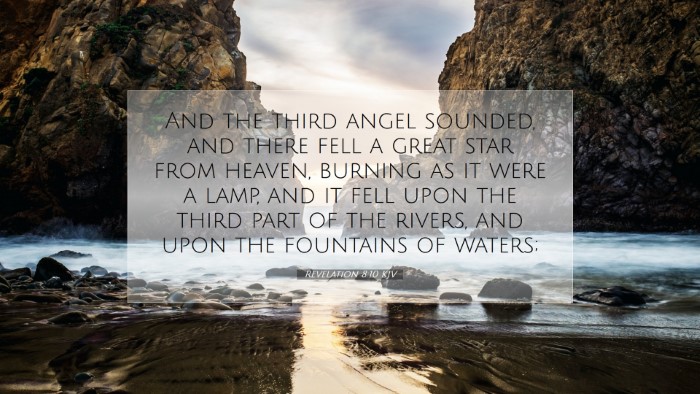Commentary on Revelation 8:10
Revelation 8:10 states: "The third angel sounded, and there fell a great star from heaven, burning as it were a lamp, and it fell upon the third part of the rivers, and upon the fountains of waters." This passage is packed with symbolism and significance that has captivated theologians and scholars for centuries. Below, we shall explore insights from prominent public domain commentaries, particularly those of Matthew Henry, Albert Barnes, and Adam Clarke.
Overview of Revelation 8:10
This verse is located within the context of the trumpet judgments, where the sounding of the third angel signifies a critical moment in the unfolding of God's judgment during the apocalyptic events. The imagery of a great star falling from heaven has been subject to various interpretations, indicating both celestial and metaphorical meanings.
Symbolism of the Great Star
The term "star" is significant in biblical literature. Matthew Henry emphasizes that stars often symbolize angels or messengers of God. In this instance, the great star represents a fallen angel or a demonic entity—perhaps a powerful agent of destruction allowed by God to enact judgment upon the earth.
Albert Barnes suggests that the "great star" may symbolize a significant leader or ruler who, in a manner similar to a star falling from the sky, loses prominence and power through divine judgment or catastrophe. The luminosity associated with the star can also indicate false teachings or misleading doctrines illuminating the path of destruction for many.
Interpretations of the Falling Star
The 'falling' nature of the star is critical, as it conveys the idea of a loss of status or divine favor. Adam Clarke notes that this imagery is reminiscent of Isaiah 14:12, which speaks of the fall of Lucifer, indicating a rebellion against God resulting in judgment. Thus, the falling star serves to warn of the precarious position of those who rebel against divine authority.
- Cosmic Collapse: The falling star symbolizes a cosmic order shook by divine judgment, reflecting the theme of upheaval and chaos that often accompanies God's interventions in human history.
- Judgment on Earth: The star's descent impacting the "third part of the rivers" represents God's judgment on creation—suggesting a spiritual tainting of water sources that signify life.
- Destruction and Purification: The burning aspect of the star points to the purifying but destructive judgments that come upon the earth, illustrating God's ultimate sovereignty over life and death.
Implications for the Waters
The impact of the great star on the rivers and fountains underscores a grievous impact on life-sustaining resources. Matthew Henry remarks that water, a vital element for sustenance, becomes corrupted by the materials that the star brings down. This suggests that God's judgment is not merely punitive but is meant to call humankind to repentance and reflection.
Barnes elaborates on the rivers, noting that water in Scripture frequently symbolizes the Spirit or the Word of God. The tainting of the waters can be seen as a metaphor for the corruption of Truth and the perversion of the Gospel, indicating a severe decline in spiritual nourishment for the inhabitants of the earth during the latter days.
Theological Reflections
Revelation 8:10 invites profound theological reflections on the nature of divine judgment. The harsh realities presented through the imagery challenge believers to consider the consequences of sin and rebellion against God. Clarke mentions that this passage serves as a reminder of human reliance on God as the source of life, cautioning against neglecting spiritual vigilance.
Lessons for Believers
- Awareness of False Teachings: Just as the fallen star impacts the rivers, so too do false teachings infiltrate and pollute the truth. Believers are encouraged to discern wisely and adhere to sound doctrine.
- Call to Repentance: The imagery serves as an urgent call for repentance, recognizing that judgments are meant to lead to restoration rather than mere condemnation.
- Hope Amidst Judgment: Finally, amidst the somber tone of judgment, there lies hope in the sovereignty of God, who is ultimately in control of the narrative of human history.
Conclusion
Revelation 8:10, rich with metaphorical significance, serves as a grave reminder of divine judgment and its implications for humanity. Whether seen as a fallen angel, a leader, or a symbol of corrupted truth, the star’s descent and its resulting effects on the waters evoke deep reflections on the necessity for spiritual vigilance, repentance, and a devoted search for truth in a world increasingly lost to falsehood.
In summary, the insights garnered from public domain commentaries like those of Matthew Henry, Albert Barnes, and Adam Clarke provide pastors, students, theologians, and Bible scholars with a comprehensive understanding of Revelation 8:10, integrating historical interpretations with practical applications relevant to today’s believers.


